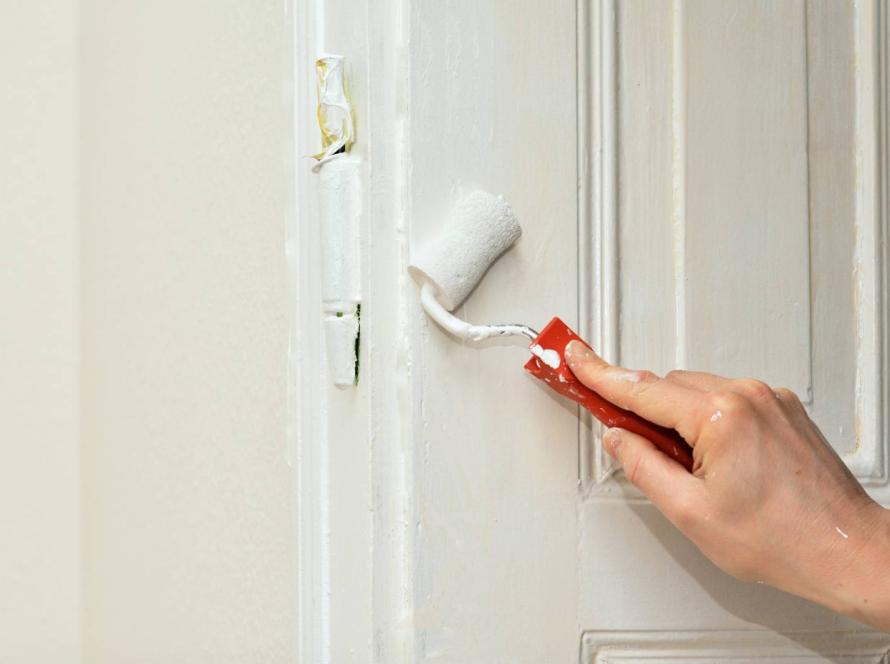Are you gearing up for a ceiling painting project and feeling a bit overwhelmed by the sheer variety of paint rollers out there? Don’t worry, you’re not alone. When it comes to giving your ceilings a fresh coat of paint, choosing the right roller is crucial for achieving that smooth, flawless finish you’re aiming for.
In this guide, we’re going to break down everything you need to know about selecting the best paint rollers for ceilings, from understanding the different roller options to figuring out which features matter most.
The Best Paint Rollers for Ceilings

When painting ceilings, the type of paint roller you choose can significantly affect the outcome and ease of the painting process. Let’s break down your options:
Nap Rollers
Nap rollers are like the workhorses of the painting world, especially when it comes to textured surfaces like popcorn or stippled ceilings. They get their name from the “nap” or fuzzy texture of the roller cover, which is made from materials like polyester or lambswool.
These rollers come in various lengths, ranging from short (around 1/4 inch) to long (up to 1 inch or more). The length of the nap determines how much paint the roller can hold and how well it can cover uneven surfaces.
Short nap rollers are best suited for smooth or lightly textured ceilings. They provide a more controlled application and minimize the risk of leaving excess texture behind. On the other hand, long nap rollers are perfect for deeper textures. They can reach into crevices and ensure thorough coverage.
One thing to keep in mind when using nap rollers is that they can leave behind lint or fibers, especially if they’re of lower quality. To avoid this issue, it’s best to use a high-quality roller cover and take care when loading and applying the paint. With the right technique, nap rollers can help you achieve a beautifully textured finish on your ceilings.
Foam Rollers
Foam rollers are a popular choice for their versatility and ease of use. These rollers are made of dense foam material (typically polyurethane) and provide a smooth and even application of paint.
A foam roller is the best paint roller for a smooth finish on surfaces like flat or lightly textured ceilings. The foam material distributes paint evenly, resulting in minimal roller marks and a professional-looking outcome.
One of the advantages of foam rollers is their easy cleanup process. Unlike nap rollers, which can be more challenging to clean due to their textured surface, foam rollers can be quickly rinsed with water and soap, making them convenient for reuse.
Foam rollers also work really well with water-based paints. This includes both latex and acrylic due to their non-absorbent nature. This makes it easy to apply thin layers of paint without excessive absorption, helping to prevent drips and streaks.
Foam rollers are particularly useful for painting smaller areas or tight spaces where precision is essential. Their compact size and smooth application make them ideal for touch-ups or detailed work around edges and corners.
Lastly, foam rollers are often available at a lower cost compared to other roller types. This makes them a budget-friendly choice for many painters. And with disposable foam rollers readily available, it’s convenient for one-time or occasional use projects.
Microfiber Rollers
These rollers are crafted from a dense, fine-textured fabric that sets them apart from traditional nap rollers. The microfiber material is designed to provide exceptional paint pickup and release. In turn, this results in smoother, even coverage on both smooth and lightly textured surfaces. This makes them a good paint roller for textured ceilings.
One of the key benefits of microfiber rollers is their ability to minimize roller marks and streaks. This leaves you with a professional-looking finish with minimal effort. Additionally, microfiber rollers are highly durable and tend to hold up well over time.
Another advantage of microfiber rollers is their versatility. Whether you’re painting ceilings with a flat finish or a slight texture. Microfiber rollers can adapt to different surfaces, ensuring consistent results throughout your project.
What to Consider When Choosing a Paint Roller for Your Project
Now that you have a basic understanding of the different types of paint rollers available, here’s how you can make the best choice for your ceiling painting project.
Paint Roller Size
When it comes to roller size, bigger isn’t always better. However, it can certainly be more efficient for covering large ceiling areas. A wider roller, such as a 9-inch or 18-inch, allows you to cover more surface area with each stroke.
This reduces the number of times you need to reload the roller with paint. Speeding up the painting process and making it easier to maintain a consistent finish across the entire ceiling.
On the other hand, smaller rollers (4-inch or 6-inch) are better suited for:
- Detail work
- Cutting in along edges
- Painting in tight spaces where a larger roller might be too cumbersome
They offer greater control and precision, making them ideal for reaching corners and around fixtures. When choosing the size of your paint roller, consider:
- The size of the room
- Accessibility of the ceiling
- Your comfort and mobility
A larger roller may be more efficient for covering expansive ceilings with minimal obstacles, while a smaller roller may be necessary for navigating around light fixtures, vents, or ceiling fans.
Ultimately, the goal is to find the right balance between coverage and control to achieve a smooth, uniform finish on your ceiling. Experimenting with different roller sizes and techniques can help you find the perfect combination for your specific painting project.
Nap Length
If your ceiling has a textured surface, such as popcorn or stipple, opting for a roller with a longer nap is best. A longer nap allows the roller to reach into the crevices and irregularities of the texture. This will ensure better coverage and a more uniform finish.
Rollers with a nap length of 3/8 inch to 3/4 inch are typically recommended for textured ceilings. For smooth ceilings or ceilings with minimal texture, a shorter nap length is preferable.
Shorter nap rollers provide better control and smoother coverage on flat surfaces, minimizing the risk of leaving behind roller marks or lint. Rollers with a nap length of 1/4 inch or less are suitable for smooth ceiling surfaces.
Some ceilings may have a combination of smooth and textured areas, requiring a versatile roller that can handle both. If this is the case, opting for a medium nap length, around 1/2 inch, offers a balanced approach that can effectively cover various surface textures without sacrificing control or finish quality.
Ease of Cleaning
Foam rollers are generally the easiest type of roller to clean. Since foam is non-porous, paint residue can be easily rinsed out with water. After use, simply rinse the foam roller under running water until the water runs clear.
For stubborn paint buildup, you can also use mild soap to help break down the paint. Once clean, allow the foam roller to air dry thoroughly before storing it for future use.
Cleaning nap rollers can be a bit more involved. This is especially true if they have longer fibers that tend to trap paint.
After use, scrape off excess paint with a putty knife or comb. Then, soak the roller in a bucket of warm, soapy water and agitate it to loosen any remaining paint.
Rinse the roller until the water runs clear, and repeat the process if necessary. Once clean, shake out any excess water and allow the roller to dry completely before storing it.
Microfiber rollers are relatively easy to clean due to their fine, dense fibers that don’t trap paint as readily as nap rollers. After painting, rinse the microfiber roller under warm water to remove most of the paint.
For stubborn paint residue, you can use a mild detergent or paint roller cleaner to help dissolve the paint. Once clean, shake out any excess water and allow the roller to air dry completely before storing it.
DIY vs. Hiring a Professional: Which Option is Best for Your Ceiling Painting Project?

As you gear up for your ceiling painting project, one of the decisions you’ll need to make is whether to tackle it yourself or enlist the help of a professional painter. DIY painting offers cost savings and a sense of accomplishment but requires time, skill, and the potential for mistakes.
On the other hand, hiring a professional ensures expertise, saves time, and guarantees professional results, albeit at a higher cost and with less control over the process.
Ultimately, the choice depends on your budget, timeline, and confidence in your painting abilities. If you’re up for the challenge and have the time to dedicate to the project, DIY painting can be rewarding. However, if you prioritize professional results and value the convenience of outsourcing the work, hiring a professional painter may be the preferred option.
Make the Right Choice for Your Painting Project

Compare Quotes from Top-rated Painting Contractors in your area.
Remember that the key to success lies in understanding your options and choosing the roller that best suits your needs and preferences.
At Alpha Living, we recognize the significance of crafting a home that mirrors your individuality, caters to your requirements, and endures the passage of time. Whenever you’re ready, enter your zip code to connect with a dependable local contractor who will ensure the job is completed to your satisfaction.





Facebook
Comments